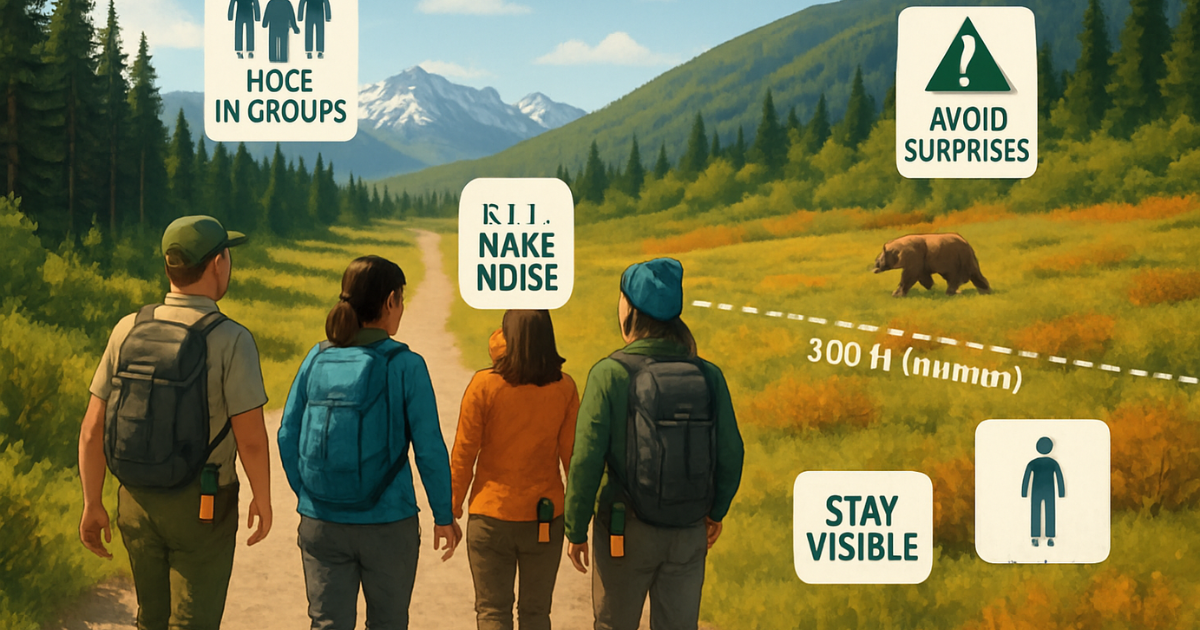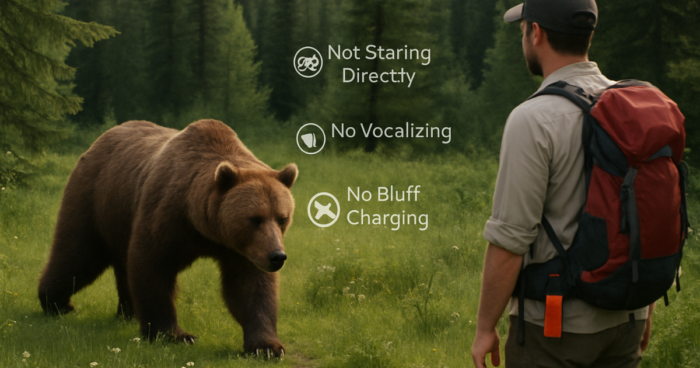Understanding bear behavior tips, especially non-aggressive signs and safety indicators, is vital for safely sharing habitat with these powerful animals. Many encounters between bears and humans occur without incident, largely because bears show clear behavioral cues that signal their intentions. Learning to read these signals not only improves human safety in bear habitats but also supports respectful wildlife encounter protocols. With the right knowledge, outdoor adventurers can interpret bear behavior more accurately and avoid unnecessary conflict. This guide highlights behavioral ecology basics and helps you identify the signs of calm, non-threatening bear behavior.
Understanding Bear Body Language Cues
One of the most effective ways to stay safe around bears is by recognizing bear body language cues. These visual signals can reveal a bear’s emotional state long before it reacts physically. Relaxed bears will often move slowly, keeping a low head posture and ears pointing slightly forward or to the sides.
Knowing how to read bear behavior starts with noting their movements. Bears that feel calm may meander, sniff the ground, or forage without paying much attention to their surroundings. Their eyes will rarely lock on humans, and they may appear uninterested in your presence. Sudden movements, upright posture, or a direct approach, however, signal a shift in demeanor.
Bear safety signals such as minimal vocalizations, relaxed pacing, and an unhurried gait generally indicate the bear is not feeling threatened. Bears that are curious but non-aggressive may also stand briefly to see or smell better, which is not necessarily a sign of threat.
Signs of Calm Bear Behavior vs Warning Signs
Learning the signs of calm bear behavior can help you avoid panic or unnecessary confrontation. Behaviors like lip-smacking, yawning, slow foraging, and sniffing are often misunderstood but usually signal a bear that is relaxed and unthreatened.
On the other hand, distinguishing bear warning signs vs friendly signs is key. While yawning may appear benign, repeated yawning combined with pacing or direct staring could signal stress. Aggressive or defensive bears may vocalize with huffs, jaw popping, growls, or clacking teeth, clear warnings that you’re too close.
Understanding defensive vs non-defensive signals is critical. Defensive behaviors occur when a bear feels cornered or threatened, standing on hind legs, bluff charging, or loud vocalizations are stress indicators that you must back away slowly. Friendly or calm signs include passive posture, minimal eye contact, and indifference to your presence. Recognizing these vocal cues and body language helps avoid escalation.
Effective Bear Avoidance Techniques and Maintaining Safe Distance

Practicing bear avoidance techniques is the best approach for staying safe in bear country. Avoid surprising bears by making noise while hiking, especially in dense brush or near streams. Clap, talk loudly, or use bear bells to alert them of your presence.
Maintaining a safe distance from bears, at least 300 feet (91 meters), ensures you respect their space and minimize stress for both parties. If you spot a bear, stop, assess its behavior, and retreat slowly if necessary. Never approach for a closer look or photo, and always keep your bear spray accessible.
Risk reduction depends on being alert and proactive. Avoid hiking alone, secure food properly, and stay on marked trails. These human safety practices align with wildlife ethics and foster safer coexistence.
Preventing Bear Aggression Through Awareness
Preventing bear aggression starts with a thorough understanding of bear behavior and proactive planning. Simple awareness, like avoiding food scents on your gear and cooking away from tents, reduces conflict potential significantly.
To succeed in preventing bear aggression, visitors must respect bear territory and avoid creating stress triggers. Sudden movements, eye contact, or attempts to approach cubs are all behaviors to avoid. These small changes support human-bear coexistence and reflect growing efforts in conflict mitigation strategies.
Understanding behavioral triggers helps reduce human-caused stress, a critical step in ensuring bears remain non-aggressive in human-dominated landscapes.
Species-Specific Notes: Brown Bear vs Grizzly Bear Behavior
While brown and grizzly bears are often used interchangeably, they exhibit subtle differences in behavior that affect interpretation. Brown bears, typically coastal and with access to rich food sources, may appear more tolerant of humans in high-traffic areas.
Grizzlies, found inland with less access to protein-rich diets, can be more defensive and territorial. This impacts how non-aggressive behavior signs are displayed. For instance, a grizzly may show agitation sooner in similar situations than a coastal brown bear.
Learn more about behavioral differences in brown bear vs grizzly bear to better interpret safety indicators.
These distinctions matter when evaluating posture, vocalizations, or threat levels and are shaped by species-specific behavioral patterns, habitat influences, and aggression thresholds.
Conclusion
Recognizing and understanding non-aggressive signs and safety indicators in bears is essential for minimizing risk and enhancing experiences in the wild. With the right knowledge and attention to bear behavior tips, outdoor explorers can safely enjoy Alaska’s rich bear habitats while supporting wildlife welfare. Learning to observe and interpret these cues contributes not only to human safety in bear habitats but also to the long-term success of wildlife encounter protocols.


